|
World Wide Telescope - Windows Only:

To me, the World Wide Telescope (WWT) was one of the most anticipated programs to be released in a long time. Here was software that laid out all available scientific surveys using a typical planetarium software platform, and switching views is a simple as the press of a button.
- No more using SIMBAD selecting a target.
- No more searches in MAST, VLA or some obscure server to find the correct image.
- No more downloading the wrong plate.
- No more scaling the multiple wavelength images for overlay.
I go to download my copy and, oops - PC only. I switched to a Mac over a year ago and use Windows software in Parallels (Windows XP) which is a virtualization program. WWT will only run on native Windows - that is if you run Windows using Boot Camp - which I don't.
I tried out the WWT on a friend's PC and really liked the program. I can see students using this program for a variety of projects and surveys. I already had a brief plan to perform a survey of galaxy clusters and their corresponding X-ray signature, which is possible with the WWT.
However, I cannot use the program - and I am not alone (just Google "World Wide Telescope for OS X").
I just simply cannot fathom the Microsoft's Research department's choice in making this a PC only program. Professional astronomers use a Linux program (which also runs on OS X) called IRAF for image processing, and (at least when I was going through school) Macs are popular with students.
This is not some money-maker, PC versus Mac type software. This is essential software that should be made available on as many platforms as possible.
Microsoft take note...
Back to Top
Second Site Image Gallery:
Being legally blind presents new challenges on a daily basis. While the irony is that I used to photograph the human retina for a living and I now have a rare genetic condition that affects my vision, I have somewhat reversed the irony by using photography to assist how I see the world.
I can no longer enjoy the around me in real-time, but I can take a picture of it, blow it up on my huge monitor and I can study the image in detail. At 20/400 vision, I can't read, drive, look at wildlife and people's faces, still image photography allows me to stare at the enlarged image at will so I can finally see things.
I invested in a Canon 40D and a few lenses - a 17-105mm zoom, a 70-200mm zoom, a 135mm fixed and a 2x extender. The camera is "spectrum enhanced" which means the IR filter was removed at the factory. This is a benefit to astrophotography but requires something called an IDAS filter for daily use.
My wife and I go for walks and she acts as the spotter. I frame the subject the best I can and take an image - many images. I rely heavily on the auto-focus of the 40D which happens to work very well.
If you use a DSLR, I highly suggest you pick up a copy of Lightroom by Adobe. It is a wonderful program that manages the images, does some basic image enhancements and creates a web gallery. Using Lightroom, I can look at my many images so I can choose the best ones for upload to my new image gallery - Second Site Image Gallery. I think the name is fitting.
For astrophotography, the enhanced 40D is quite a performer. I would like to share a few with you now - they are also posted on the gallery.
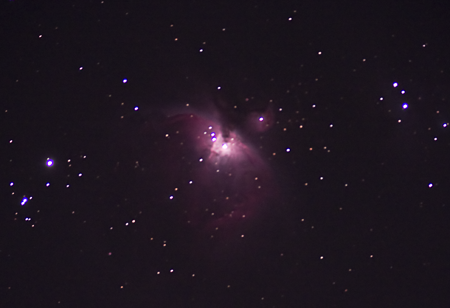
This first image is of the Orion Nebula - M42. It is a single 30 second image taken with the Canon 40D through a Meade 80mm apochromatic.

This second image is of the moon through the Meade 80mm apochromatic. The IDAS filter is in place in the Canon 40D.
For those who wish to do astrophotography with a DSLR camera, I highly recommend "Digital SLR Astrophotography" by Michael Covington. This book discuses how the camera works, techniques for imaging, techniques for image processing and much more. I was able to read the book before I lost my vision. Because of this, my wife helps me to recap on things I forgot.
For those out there who have lost their vision, don't let that stop you from doing what you want! Anything is possible if you put your mind to it.
Please enjoy the Second Site Image Gallery.
Back to Top
Astrocast TV:

MEDIA RELEASE
Contact: mailto:info@astrocast.tv FOR IMMEDIATE RELEASE
ASTRONOMY & TV PROS JOIN FORCES TO ANNOUNCE THE BIRTH OF A NEW STAR Astrocast.TV <http://astrocast.tv/> premiers on the Internet
Centreville,VA.—March 20, 2008-- Astrocast.TV <http://astrocast.tv/> announces the launch of the first of its kind webcast for experienced amateur astronomers and anyone interested in learning about our universe in visually rich format. On March 24, 2008 Astrocast will be launched and hosted by an impressive roster of individuals including NASA/Jet Propulsion Laboratory Solar System Ambassadors, Greg Redfern and Greg Piepol; with Astrocast Special Advisor, Dr. Harold Geller, Associate Chair of the Department of Physics and Astronomy, George Mason University (GMU).
Recognizing the need to inform and educate people of all ages about astronomy and space science, Executive Producer Richard C. Mathews said the Astrocast team of Redfern, Piepol and Geller wanted to share their wealth of knowledge and experience so that many who view this program gain a better understanding. “Our goal is to increase public awareness of astronomy and our solar system and how it impacts our lives,” said Mathews.
Co-host, Redfern’s writings, media appearances, and public lectures on astronomy and space exploration have reached thousands for over four decades. He was host during a live TV-Internet broadcast Hour 4 of Space Day 1999 Cybercast at the National Air and Space Museum. Redfern continues his public outreach as a NASA JPL Solar System Ambassador. Redfern can be seen regularly on WTTG Fox 5 and internationally on the Voice of America. For more information visit Greg's WTTG-TV Fox DC Blog site, “SkyGuy’s Blog” at http://community.myfoxdc.com/blogs/category/WEATHER and WTOP News at http://www.wtopnews.com/?nid=422&sid=latest <http://www.wtopnews.com/?nid=422&sid=latest> for his column, “What’s Up? The Space Place”.

“A person’s first look at the sun through a properly equipped telescope is not quickly forgotten, remarks Piepol, it’s that good!” Piepol, also serving as the show’s co-host, is actively involved with solar outreach and travels around the United States sharing his fascination with our closest star. His presentations include 3D, video and sound to inform and inspire others to look safely into the sun. His solar images have been used on MSNBC, The History Channel, Nature Magazine and hundreds of worldwide resources. Greg received the Astronomical League’s first ever “Webmaster of the Year” award in 2003. His website http://www.sungazer.net <http://www.sungazer.net/> was awarded the Griffith Observatory Star Award for its promotion of astronomical awareness.
Dr. Geller <http://www.physics.gmu.edu/wiki/People:Profiles:Harold_Geller> http://www.physics.gmu.edu/wiki/People:Profiles:Harold_Geller <http://www.physics.gmu.edu/wiki/People:Profiles:Harold_Geller> will play a dual role serving as the show’s advisor as well as host of the Astrocast.TV Q & A segment. His achievements include co-designing the first astrobiology course taught at GMU, within the general education Honors Program; and he designed, developed and funded the construction of George Mason University’s new observatory, to be completed in 2008 with the installation of a 32-inch Ritchey Chrétien telescope.
“Star gazing isn’t only exciting, but it’s about seeing both the past and our future” exclaims Mathews, “I want to send a message and have people look at life from literally another point of view.” Astrocast.TV <http://astrocast.tv/> is the creation of Executive Producer Mathews, a former television Producer/Director for CNN Headline News, NBC, WORLDNET and the Voice of America whose fascination with space exploration grew during his years of directing a number of NASA Space Shuttle launches/landings and repair missions for CNN/HN.
But the program would not be complete without the assistance of his son Chris Mathews, a 3-D animation artist who provides graphic and animation elements to support the visually rich show format.
Astrocast.TV <http://astrocast.tv/> is a webcast produced by Midnight Rider Productions, LLC, a company developing and marketing sophisticated and elegant video production techniques for the internet.
Back to Top
SBIG Hall Of Fame:
Santa Barbara Instrument Group (SBIG), renowned producers of leading CCD imaging camera, has created a Hall of Fame for imagers who push the envelope in amateur astronomy.
The choices for who receives this prestigious honor are done internally at SBIG. So far, I am in total agreement with their choices. The imagers listed below have received this honor, and do produce some of the most beautiful images I have ever seen. In many cases they can rival images from the Hubble Space Telescope.
The honorees:
- Tony Hallas - producing some of the most detailed images, and one of the first users of SBIG gear. He has a setup to dream for.
- Robert Gendler - having the pleasure to have spoken with Dr. Gendler, he produces some of the coveted images, yet remains a very humble and accessible person. I actually purchased one of his images. It hangs in my bedroom.
- Johannes Schedler - Producing very fine images, he has become and expert on DSLR imaging - authoring a chapter in Digital Astrophotography (ISBN 1852337346).
- Daniel Verschatse - having access to very clear skies in South America, he produces some extremely detailed images that have been previewed in Sky and Telescope and Astronomy magazines numerous times.
- Russell Croman - I have repeated this, but Mr. Croman produces some of he most beautiful images I have seen. He is also one of the most hard working imagers I know and his PhotoShop technique is to die for.
- Volker Wendel - another fine imager, he produces some of the best images of planetary nebula I have seen. He is the member of the "Spiegelteam" with fellow imager Bernd Flach-Wilken.
- Bernd Flach-Wilken - part of the "Spiegelteam," his honor is well deserved.
- R. Jay GaBany - considered a good friend of mine, Mr. GaBany produces some of the most detailed images of nebula I have seen. He also has techniques in PhotoShop to die for. His images have also appeared numerous times in the Astronomy and Sky and Telescope magazines as well as the APOD.
- Kunihiko Okano - his use of DDP (Digital Development Processing) and use of relatively inexpensive gear has produced extremely clear images of planets and deep space objects.
- Thierry Legault - his subject matter ranges from the moon and planets, the Sun as well as deep space objects; all of which are simply beautiful.
There will be more people nominated in the future so stay tuned!
Back to Top
2007 - A Great Year for Astronomy:
2007 was a phenomenal year for astronomy - from naked eye comets to mapping of Dark Matter. Astronomy Magazine's January 2008 issue coverers their top 10 stories, most of which I won't cover in this entry. That doesn't mean that any one story is less important, most of them have already been covered in previous entries - like Comet McNaught, Titan's oceans, and New Horizons flyby of Jupiter.
While the Huygens probe landed with a "thud" and not a splash, the ocean real estate was detected by the orbiting Cassini probe.

This image shows one of the many lakes, this one a bit larger than Lake Superior. Cassini used radar mapping to detect these methane-ethane oceans in the northern polar region.
Cassini has also given us some great views of Saturn's other moons, such as Iapetus.
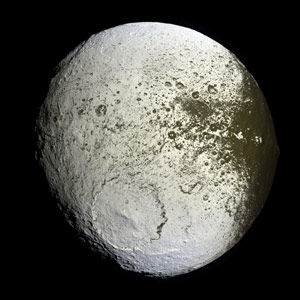
And some great close up's of the light and dark regions:
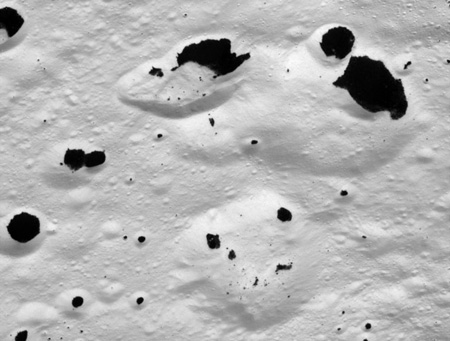
The dark material that covers part of this moon is thought to be methane leaking to the surface due to meteoric impacts. This methane would turn dark due to exposure to the Sun's ultraviolet radiation.
More images from Cassini can be found on the Cassini Multimedia website.
The New Horizons mission fly by Jupiter earlier in 2007 with the purpose of testing the instrument package.

The result of the test is that for the first time the extent of Jupiter's magnetosphere has been measured - and it's huge.
The greatest strides this year are in the area of theoretical and observational astrophysics.
The smallest transiting planet was discovered in April 2007 orbiting the red dwarf GJ 436. Residing 30 light years from Earth, the planet is the mass of Neptune. Better still, the planet orbits within the stars "habitable zone," meaning that if this planet has liquid water, life could exist.
Astronomers at the Harvard-Smithsonian Center for Astrophysics settled the folk-lore regarding the merger of our Milky Way galaxy and M31 - the Andromeda Galaxy. The two galaxies will merge, with the first pass occurring in 2 billion years. The final merging will occur in 5 billion years and there is a 50% chance our Solar System will be cast away due to strong gravity interactions. The model is based on the known visual mass of both galaxies as well as Dark Matter.
Our Universe is 13.7 billion years old and the ESO's VLT has discovered the oldest star - 13.2 billion years old.

This star, designated HE 1523-0901, is important for several reasons. This stellar fossil's age was determined using several "clocks" of neutron capture - the decay of radioactive elements thorium, uranium, europium, osmium and iridium. This is the first time multiple elements were used to date a star. Because this star resides in our galaxy, we can also better determine the age of our galaxy - presumably at least 13.2 billion years old.
To look for old stars, astronomers look for stars with the least amount of iron - called iron-poor. These stars will have higher percentages of radioactive material that can be used to date these stars. Data from old stars can also assist astronomers in putting together better simulations of galaxy formation.
Voyager 2 is still sending back data from is Plasma Science Instrument.

Several surprises have resulted from this data. The first surprise is the interstellar magnetic field is stronger than expected and distorts the Sun's heliopause - not the perfect sphere that was expected. Also, the heliopause expands and contracts - Voyager 2 passed through the heliopause several times. This is a result of changing activity from the Sun, i.e. sunspots and CME's. In addition, the temperature beyond the heliopause is 10 times colder than expected. There is no explanation for this yet.
Voyager 1 still sends back data, but its Plasma Science Instrument has failed.
One of the more extraordinary experiments is that of the Gravity Probe B. Placed in polar orbit, this satellite is one of the most strict tests of Einstein's General Relativity theory.
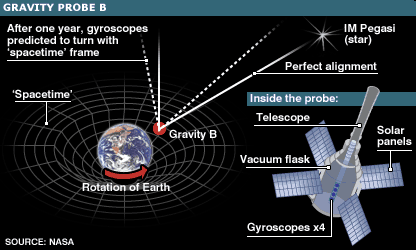
The test so far is a success. The purpose is to detect what is called "frame-dragging," the twisting of space-time by a rotating massive object. The data is still being analyzed, but so far the data is in agreement to Einstein's theory within only 1%. To me this is simply amazing - that a theory derived in 1916 has stood the test of time and numerous experiments.
With construction finally complete in 2007, the Large Hadron Collider (LHC) will begin its first scientific experiments in the summer of 2008.

The LHC is very important to particle physicists and astronomers for its the hope this collider can produce the elusive Higg's particle - a particle that is thought to have existed a short time during the Big Bang. This particle is responsible for assigning mass to other particles. The presence of the Higg's will help in proving the Big Bang theory.
And the final story...
Combing 1,000 hours of Hubble Space Telescope time and 400 hours of the XMM-Newton x-ray telescope (and color image data from the ESO's Very Large Telescope, the Canada-France-Hawaii telescope, the Subaru telescope and the Keck Observatory), the Cosmic Evolution Survey (COSMOS) surveyed a 2 square degree area in the constellation Sextans to create a first ever 3 dimensional map of Dark Matter.
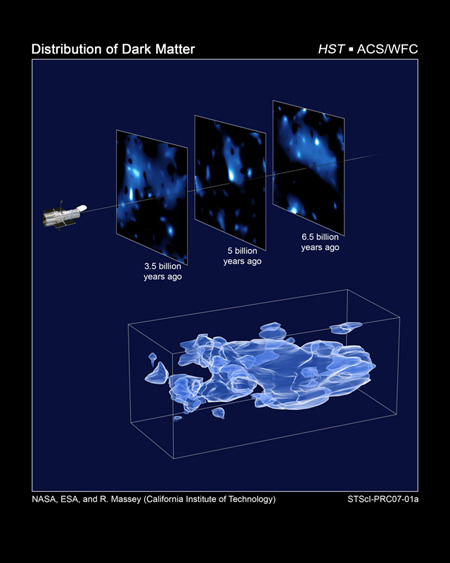
Gravity lensing was the key in construction of the map. By studying data from the Hubble, they gathered statistical data on what lensed galaxy should look like and therefore calculated the strength of the lens. In addition to showing the distribution of Dark Matter, the survey also shows the growth of galaxies over time.
2007 was a great year for astronomy, and I look forward to the coming year - especially with the initial results of the Large Hadron Collider coming in the summer. In addition, the Hubble Space Telescope is due for its final service in May 2008.
Back to Top
What's NASA Up To?:
So what is around the corner for space exploration? What plans does NASA have? I was curious so I searched about - not just with NASA, but with the European, Japanese and Chinese Space Agencies.
The Chinese Space Agency was easy to find information for, or rather the lack of. Their website is most likely purposefully cryptic and lacking in any future details.
NASA has the lead for future plans, with previously cancelled missions back on the boards. Most exciting for me, because I have an interest in exoplanets, is the formerly cancelled Kepler Mision. Schedules for launch in 2009, the Kepler space telescope will be the largest so far at 0.95 meters (mirror diameter). The telescope will stare at a single field betweeen the star Vega (in Lyra) and Cygnus measuring the brightness of 100,000 G, K and M-class stars. The goal is to measure the brightness changes of an Earth sized body transiting the host star.
Other missions:
- Dawn, launched on September 27, 2007 will visit the largest asteroids in our asteroid belt
- Phoenix will launch next year for a visit to Mars in the search for water.
- In keeping with the Mars theme, the Mars Science Laboratory is in the design stages.
- The Lunar Reconnaissance Orbiter will visit the Moon (obviously) to prepare for future human exploration.
- Finally, the NuSTAR Mission is in the preliminary design stages that will look for Black Holes.
The ESA (European Space Agency) is in a quiet stage of mission planning with only the BepiColumbo probe in the design stages. With a launch in August 2013, this probe will visit the planet Mercury and will study how a planet evolved close to its parent star.
The Japanese are busy with a few projects as well:
- SELENE, Japan's first visit to the moon with any spacecraft, was launched on September 14, 2007.
- Solar-B launched on September 21, 2006 for study of our Sun.
- Planet-C is in the design stages for a visit to Venus.
That is all for now. If any new missions creep up I'll post the information here.
Back to Top
September 2007 News:
My vision has taken a turn for the worse. I have been placed on permanent disability and will be forced to retire early. There are mixed blessings with this of course, and I am happy to have achieved so much in my 37 years on this Earth.
I have only done very minor updates to the site. Even with my huge 30" monitor, things are tricky. When one lowers the ideal resolution of an LCD, things get pixilated and that adds to the hard ship.
As I mentioned before, I have started playing the drums again - which is one thing I can do that requires little visual assistance. I have even created a new website dedicated to this: AstroDrummer.com. Soon I will have audio clips of my playing.
In the world of astronomy, all I can report are two new books - I cannot read them without the aide of an 8x photo loupe (and that is one word at a time). Universe by Freedman and Kaufmann is a highly respected text that is now in its 8th edition.
The other text is The Arp Atlas of Peculiar Galaxies by Kanipe and Webb. Some of the images in the book were contributed to my good friend and fellow alumnus Tim Hunter.
Back to Top
Serious changes to the Website :
Greetings to all my faithful readers. For the past many months I have have been dealing with some health issues. A cardiac exam resulted in a healthy hearth, but unexplained rapid heart beat prompted a special test to check epinephrine levels. It turns out these levels are high and while a high level is indicative of high blood pressure, my heart exam does not reflect this. The only other cause is something called a phoeochromocytoma - a treatable tumor by surgery. However, in my case this has gone on for so long that my vision has been affected. I can barely read this entry even using OS X's magnification tool.
As a result, I barely make changes or add content to this site. I cannot use binoculars or telescopes or enjoy photography (well I can try, but I cannot see the tools within PhotoShop). Changes and updates will be slow so please be patient
Luckily with the help of Apple's 30" monitor, I can use the computer enough to write this entry. I am also "training" iListen - a voice recognition program - to assist me in 'typing' as seeing the keyboard is also extremely difficult. With luck, I'll be slowly increasing the frequency of updates and additional content to the website.
Back to Top
Changes to the Website :
Regular visitors to Astronomy Online have probably noticed some changes. These changes are out of unfortunate necessity.This site and all its expenses are covered by my and my wife's day jobs - however, my wife will soon loose her job due to company cutbacks. This is an unfortunate reality in the tech world: get rid of your experienced programmers in favor of younger, cheaper workers.
I have had to take down my Blog (which I planned to do anyway) and power down my server. I moved the website to a webhost - Network Solutions. The savings in electricity pays for the yearly hosting fee.
These changes mean expansions to the site must be abandoned, and purchase of any equipment be put on hold. One thing I still refuse to do is subject my visitors to advertising.
Donations are more than welcome.
The main page has been cleaned up. The links to the Webby Awards and other website related honors have been moved to the Introduction page. While I am happy to receive any honors regarding the website, the idea of the website is to provide information related to astronomy.
A thumbnail of the Webby nomination has been added to the copyright bar of the website (bottom).
Major changes include the closure of the forum. While additional users were trickling in, there just wasn't the activity I hoped for. There are better, more active forums available and I have provided links to them.
The coming events calendar has been replaced with links to other calendar services. While the calendar is nice, it was limited to what information could be displayed. Links to Heavens Above and CalSKY will provide a vast array of data specific to the users location - much better than I can provide. The "current images" have also been moved to the coming events page.
I hope these changes are helpful as well as aesthetically pleasing. As always, thank you for visiting Astronomy Online.
Back to Top
Extended Groth Strip - 50,000 Galaxies:
Several hundred images taken with NASA's Hubble Space Telescope have been woven together into a rich tapestry of at least 50,000 galaxies. The Hubble view is yielding new clues about the universe's youth, from its "pre-teen" years to young adulthood.
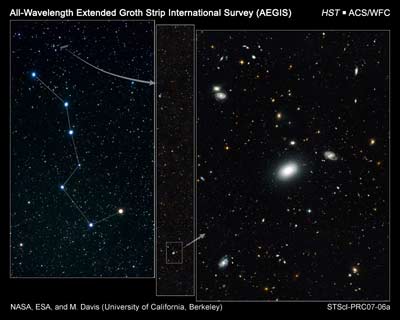
Among the discoveries so far in this galactic tapestry are a giant red galaxy with two black holes at its core; several new gravitational lenses — galaxies whose gravity bends the light from background galaxies into multiple images; and a rogues' gallery of weird galaxies that should keep astronomers busy for a long time trying to explain them.
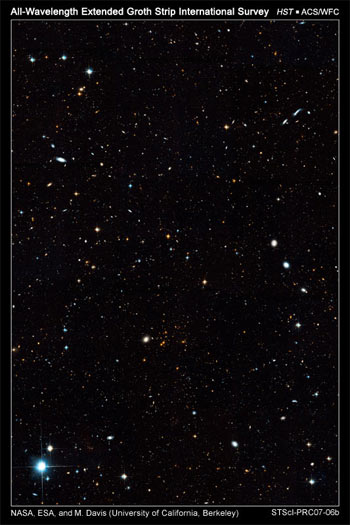
To cover even this much of the sky, Hubble's Advanced Camera for Surveys snapped more than 500 separate exposures, at 63 different pointings, spread out over the course of one year. The final mosaic is 21 images long by 3 images tall. (The dimensions in degrees are about 1.1 by 0.15 degrees. For comparison, the Moon is about 0.5 degrees in angular size).
The Extended Groth Strip is named for Princeton University physicist Edward Groth.
Source: Hubble News Center
Back to Top
Hubble Sees 'Comet Galaxy' Being Ripped Apart By Galaxy Cluster:
NASA's Hubble Space Telescope, in collaboration with several other ground- and space- based telescopes, has captured a galaxy being ripped apart by a galaxy cluster's gravitational field and harsh environment.

The finding sheds light on the mysterious process by which gas-rich spiral-shaped galaxies might evolve into gas-poor irregular- or elliptical-shaped galaxies over billions of years. The new observations also reveal one mechanism for forming the millions of "homeless" stars seen scattered throughout galaxy clusters.
Source: Hubble News Center
Back to Top |

